Analysis of Project Management Complexity: A University Report
VerifiedAdded on 2020/05/16
|6
|1079
|71
Report
AI Summary
This report examines various aspects of project management complexity, focusing on key methodologies and challenges. It begins by discussing Shermon's view on parametric models as a budgeting tool, highlighting its unbiased nature and application in the Australian Public Service. The report then explores the impact of both positive and negative experiences on project managers' learning and growth, emphasizing the importance of self-awareness. It further addresses the need to avoid deliberate deception and the significance of being receptive to new information. The report also tackles the challenges of managing unique projects where past case studies may not be applicable, requiring managers to rely on their own skills and adaptability. Finally, it touches upon the use of system dynamics in developing models to understand patterns and trends, while acknowledging the complexities of modeling human behavior, particularly in relation to deception.
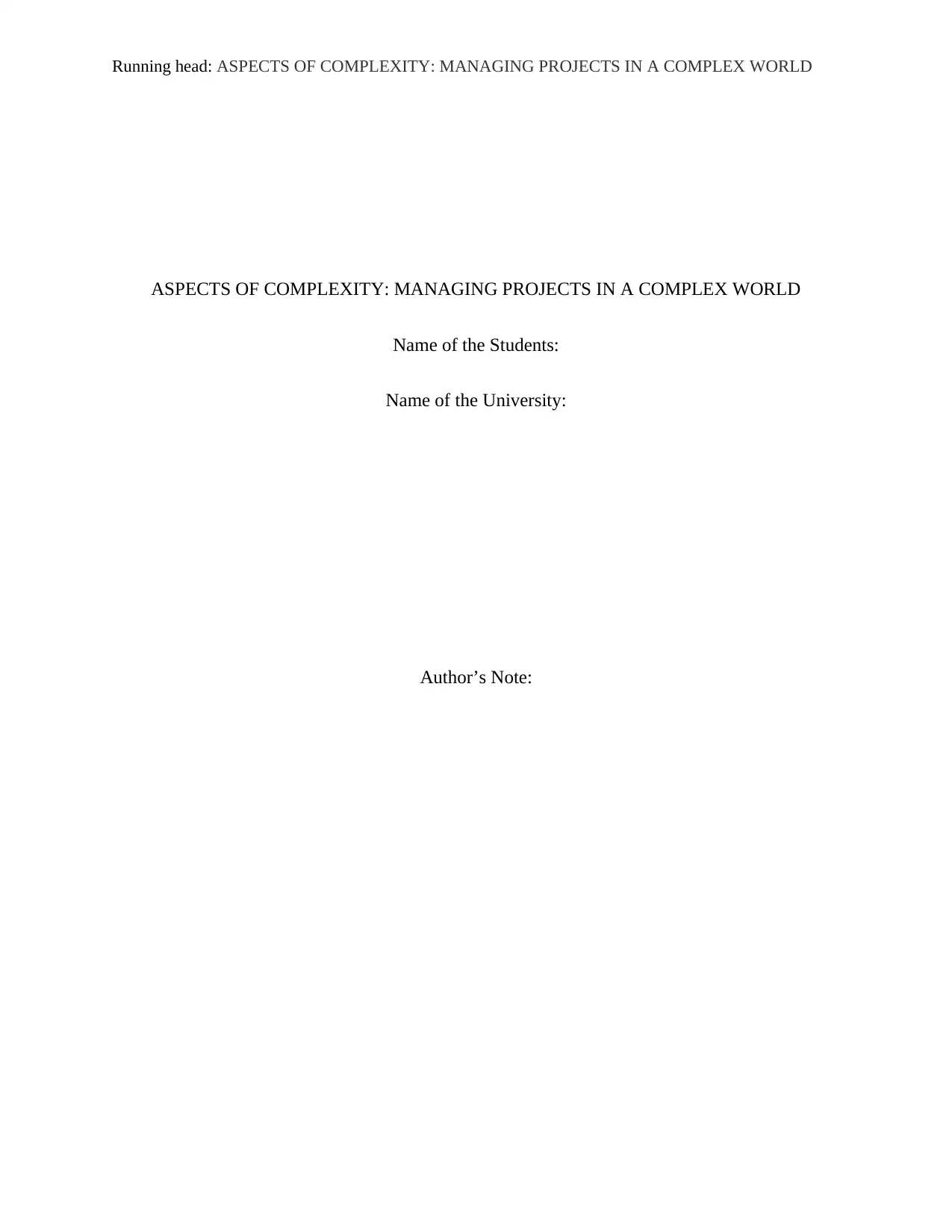
Running head: ASPECTS OF COMPLEXITY: MANAGING PROJECTS IN A COMPLEX WORLD
ASPECTS OF COMPLEXITY: MANAGING PROJECTS IN A COMPLEX WORLD
Name of the Students:
Name of the University:
Author’s Note:
ASPECTS OF COMPLEXITY: MANAGING PROJECTS IN A COMPLEX WORLD
Name of the Students:
Name of the University:
Author’s Note:
Paraphrase This Document
Need a fresh take? Get an instant paraphrase of this document with our AI Paraphraser
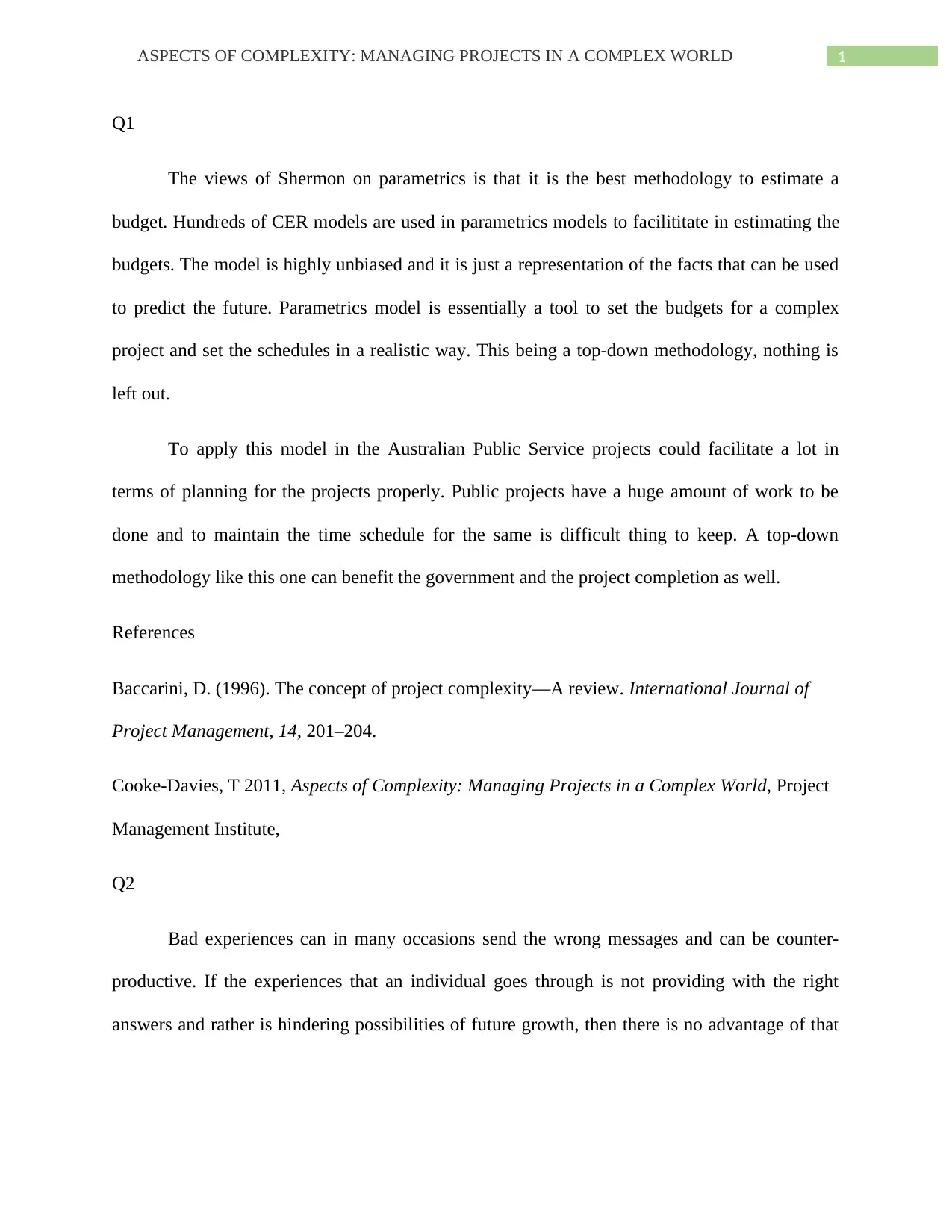
1ASPECTS OF COMPLEXITY: MANAGING PROJECTS IN A COMPLEX WORLD
Q1
The views of Shermon on parametrics is that it is the best methodology to estimate a
budget. Hundreds of CER models are used in parametrics models to facilititate in estimating the
budgets. The model is highly unbiased and it is just a representation of the facts that can be used
to predict the future. Parametrics model is essentially a tool to set the budgets for a complex
project and set the schedules in a realistic way. This being a top-down methodology, nothing is
left out.
To apply this model in the Australian Public Service projects could facilitate a lot in
terms of planning for the projects properly. Public projects have a huge amount of work to be
done and to maintain the time schedule for the same is difficult thing to keep. A top-down
methodology like this one can benefit the government and the project completion as well.
References
Baccarini, D. (1996). The concept of project complexity—A review. International Journal of
Project Management, 14, 201–204.
Cooke-Davies, T 2011, Aspects of Complexity: Managing Projects in a Complex World, Project
Management Institute,
Q2
Bad experiences can in many occasions send the wrong messages and can be counter-
productive. If the experiences that an individual goes through is not providing with the right
answers and rather is hindering possibilities of future growth, then there is no advantage of that
Q1
The views of Shermon on parametrics is that it is the best methodology to estimate a
budget. Hundreds of CER models are used in parametrics models to facilititate in estimating the
budgets. The model is highly unbiased and it is just a representation of the facts that can be used
to predict the future. Parametrics model is essentially a tool to set the budgets for a complex
project and set the schedules in a realistic way. This being a top-down methodology, nothing is
left out.
To apply this model in the Australian Public Service projects could facilitate a lot in
terms of planning for the projects properly. Public projects have a huge amount of work to be
done and to maintain the time schedule for the same is difficult thing to keep. A top-down
methodology like this one can benefit the government and the project completion as well.
References
Baccarini, D. (1996). The concept of project complexity—A review. International Journal of
Project Management, 14, 201–204.
Cooke-Davies, T 2011, Aspects of Complexity: Managing Projects in a Complex World, Project
Management Institute,
Q2
Bad experiences can in many occasions send the wrong messages and can be counter-
productive. If the experiences that an individual goes through is not providing with the right
answers and rather is hindering possibilities of future growth, then there is no advantage of that
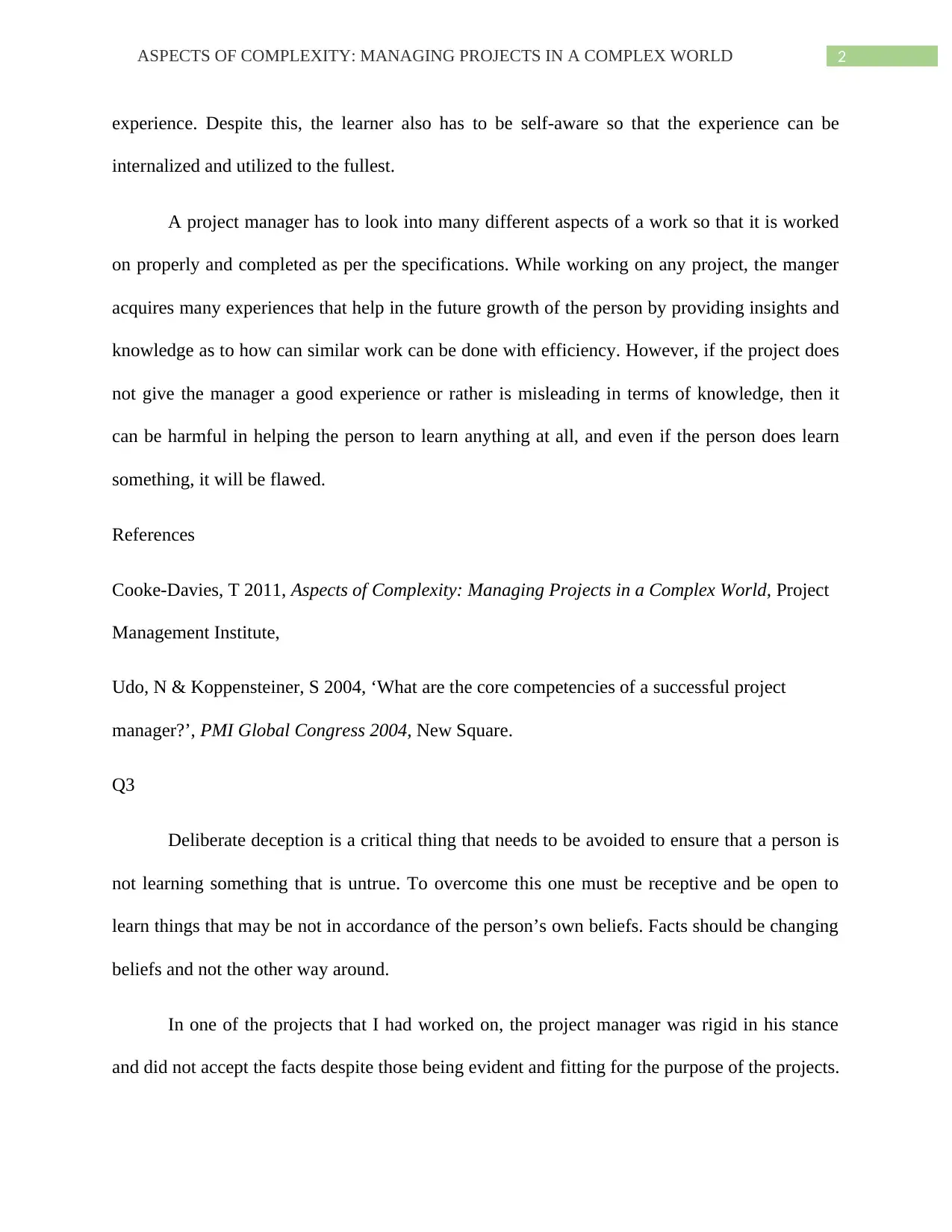
2ASPECTS OF COMPLEXITY: MANAGING PROJECTS IN A COMPLEX WORLD
experience. Despite this, the learner also has to be self-aware so that the experience can be
internalized and utilized to the fullest.
A project manager has to look into many different aspects of a work so that it is worked
on properly and completed as per the specifications. While working on any project, the manger
acquires many experiences that help in the future growth of the person by providing insights and
knowledge as to how can similar work can be done with efficiency. However, if the project does
not give the manager a good experience or rather is misleading in terms of knowledge, then it
can be harmful in helping the person to learn anything at all, and even if the person does learn
something, it will be flawed.
References
Cooke-Davies, T 2011, Aspects of Complexity: Managing Projects in a Complex World, Project
Management Institute,
Udo, N & Koppensteiner, S 2004, ‘What are the core competencies of a successful project
manager?’, PMI Global Congress 2004, New Square.
Q3
Deliberate deception is a critical thing that needs to be avoided to ensure that a person is
not learning something that is untrue. To overcome this one must be receptive and be open to
learn things that may be not in accordance of the person’s own beliefs. Facts should be changing
beliefs and not the other way around.
In one of the projects that I had worked on, the project manager was rigid in his stance
and did not accept the facts despite those being evident and fitting for the purpose of the projects.
experience. Despite this, the learner also has to be self-aware so that the experience can be
internalized and utilized to the fullest.
A project manager has to look into many different aspects of a work so that it is worked
on properly and completed as per the specifications. While working on any project, the manger
acquires many experiences that help in the future growth of the person by providing insights and
knowledge as to how can similar work can be done with efficiency. However, if the project does
not give the manager a good experience or rather is misleading in terms of knowledge, then it
can be harmful in helping the person to learn anything at all, and even if the person does learn
something, it will be flawed.
References
Cooke-Davies, T 2011, Aspects of Complexity: Managing Projects in a Complex World, Project
Management Institute,
Udo, N & Koppensteiner, S 2004, ‘What are the core competencies of a successful project
manager?’, PMI Global Congress 2004, New Square.
Q3
Deliberate deception is a critical thing that needs to be avoided to ensure that a person is
not learning something that is untrue. To overcome this one must be receptive and be open to
learn things that may be not in accordance of the person’s own beliefs. Facts should be changing
beliefs and not the other way around.
In one of the projects that I had worked on, the project manager was rigid in his stance
and did not accept the facts despite those being evident and fitting for the purpose of the projects.
⊘ This is a preview!⊘
Do you want full access?
Subscribe today to unlock all pages.

Trusted by 1+ million students worldwide
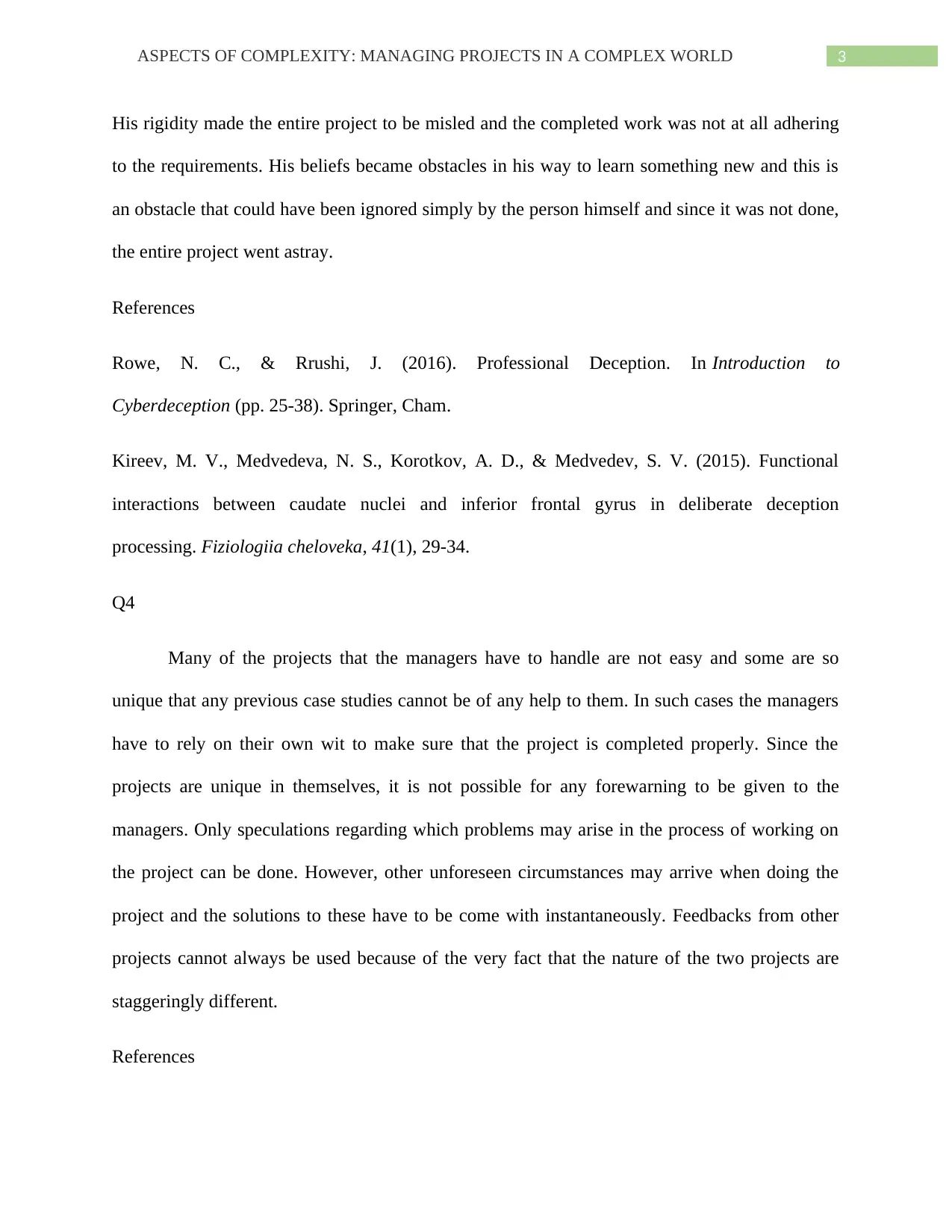
3ASPECTS OF COMPLEXITY: MANAGING PROJECTS IN A COMPLEX WORLD
His rigidity made the entire project to be misled and the completed work was not at all adhering
to the requirements. His beliefs became obstacles in his way to learn something new and this is
an obstacle that could have been ignored simply by the person himself and since it was not done,
the entire project went astray.
References
Rowe, N. C., & Rrushi, J. (2016). Professional Deception. In Introduction to
Cyberdeception (pp. 25-38). Springer, Cham.
Kireev, M. V., Medvedeva, N. S., Korotkov, A. D., & Medvedev, S. V. (2015). Functional
interactions between caudate nuclei and inferior frontal gyrus in deliberate deception
processing. Fiziologiia cheloveka, 41(1), 29-34.
Q4
Many of the projects that the managers have to handle are not easy and some are so
unique that any previous case studies cannot be of any help to them. In such cases the managers
have to rely on their own wit to make sure that the project is completed properly. Since the
projects are unique in themselves, it is not possible for any forewarning to be given to the
managers. Only speculations regarding which problems may arise in the process of working on
the project can be done. However, other unforeseen circumstances may arrive when doing the
project and the solutions to these have to be come with instantaneously. Feedbacks from other
projects cannot always be used because of the very fact that the nature of the two projects are
staggeringly different.
References
His rigidity made the entire project to be misled and the completed work was not at all adhering
to the requirements. His beliefs became obstacles in his way to learn something new and this is
an obstacle that could have been ignored simply by the person himself and since it was not done,
the entire project went astray.
References
Rowe, N. C., & Rrushi, J. (2016). Professional Deception. In Introduction to
Cyberdeception (pp. 25-38). Springer, Cham.
Kireev, M. V., Medvedeva, N. S., Korotkov, A. D., & Medvedev, S. V. (2015). Functional
interactions between caudate nuclei and inferior frontal gyrus in deliberate deception
processing. Fiziologiia cheloveka, 41(1), 29-34.
Q4
Many of the projects that the managers have to handle are not easy and some are so
unique that any previous case studies cannot be of any help to them. In such cases the managers
have to rely on their own wit to make sure that the project is completed properly. Since the
projects are unique in themselves, it is not possible for any forewarning to be given to the
managers. Only speculations regarding which problems may arise in the process of working on
the project can be done. However, other unforeseen circumstances may arrive when doing the
project and the solutions to these have to be come with instantaneously. Feedbacks from other
projects cannot always be used because of the very fact that the nature of the two projects are
staggeringly different.
References
Paraphrase This Document
Need a fresh take? Get an instant paraphrase of this document with our AI Paraphraser
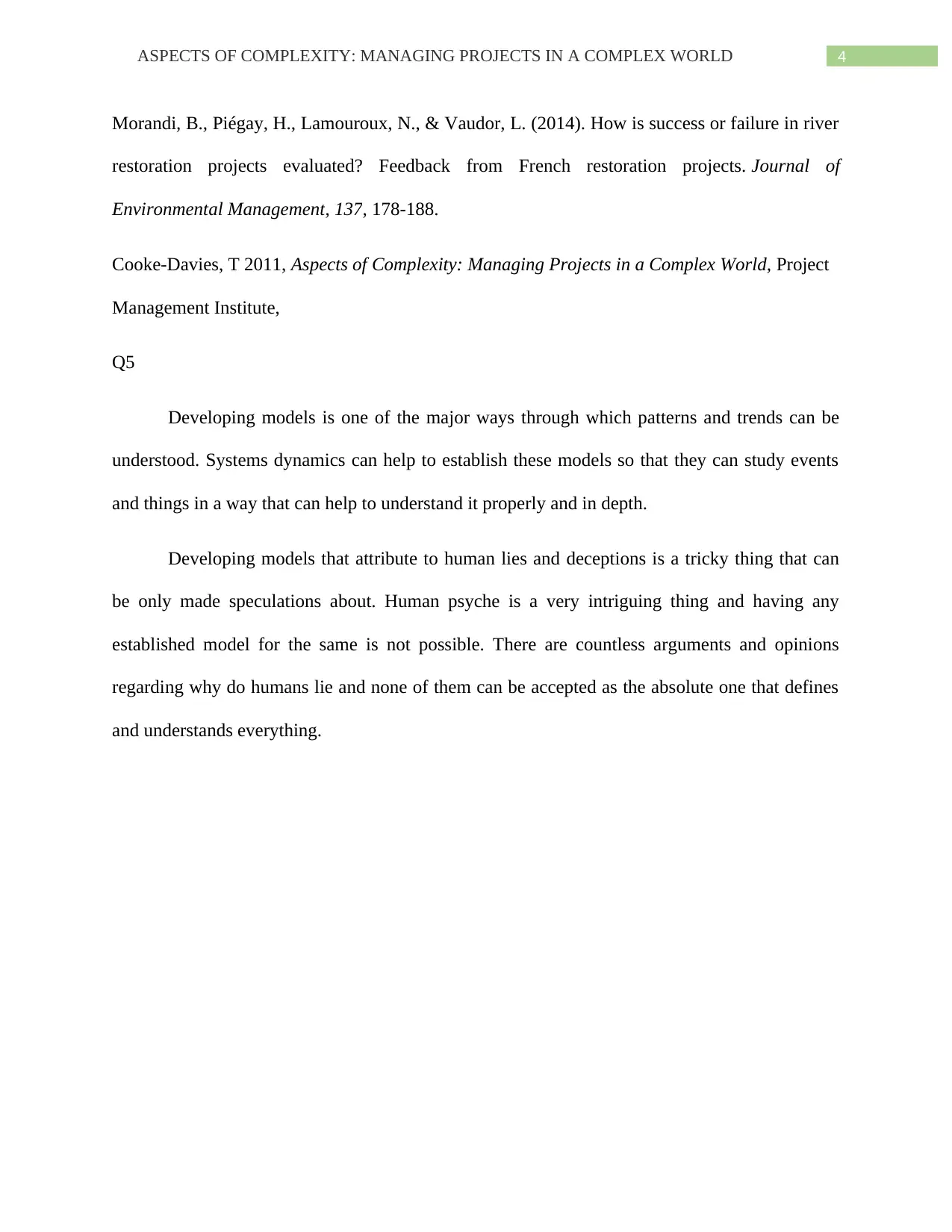
4ASPECTS OF COMPLEXITY: MANAGING PROJECTS IN A COMPLEX WORLD
Morandi, B., Piégay, H., Lamouroux, N., & Vaudor, L. (2014). How is success or failure in river
restoration projects evaluated? Feedback from French restoration projects. Journal of
Environmental Management, 137, 178-188.
Cooke-Davies, T 2011, Aspects of Complexity: Managing Projects in a Complex World, Project
Management Institute,
Q5
Developing models is one of the major ways through which patterns and trends can be
understood. Systems dynamics can help to establish these models so that they can study events
and things in a way that can help to understand it properly and in depth.
Developing models that attribute to human lies and deceptions is a tricky thing that can
be only made speculations about. Human psyche is a very intriguing thing and having any
established model for the same is not possible. There are countless arguments and opinions
regarding why do humans lie and none of them can be accepted as the absolute one that defines
and understands everything.
Morandi, B., Piégay, H., Lamouroux, N., & Vaudor, L. (2014). How is success or failure in river
restoration projects evaluated? Feedback from French restoration projects. Journal of
Environmental Management, 137, 178-188.
Cooke-Davies, T 2011, Aspects of Complexity: Managing Projects in a Complex World, Project
Management Institute,
Q5
Developing models is one of the major ways through which patterns and trends can be
understood. Systems dynamics can help to establish these models so that they can study events
and things in a way that can help to understand it properly and in depth.
Developing models that attribute to human lies and deceptions is a tricky thing that can
be only made speculations about. Human psyche is a very intriguing thing and having any
established model for the same is not possible. There are countless arguments and opinions
regarding why do humans lie and none of them can be accepted as the absolute one that defines
and understands everything.
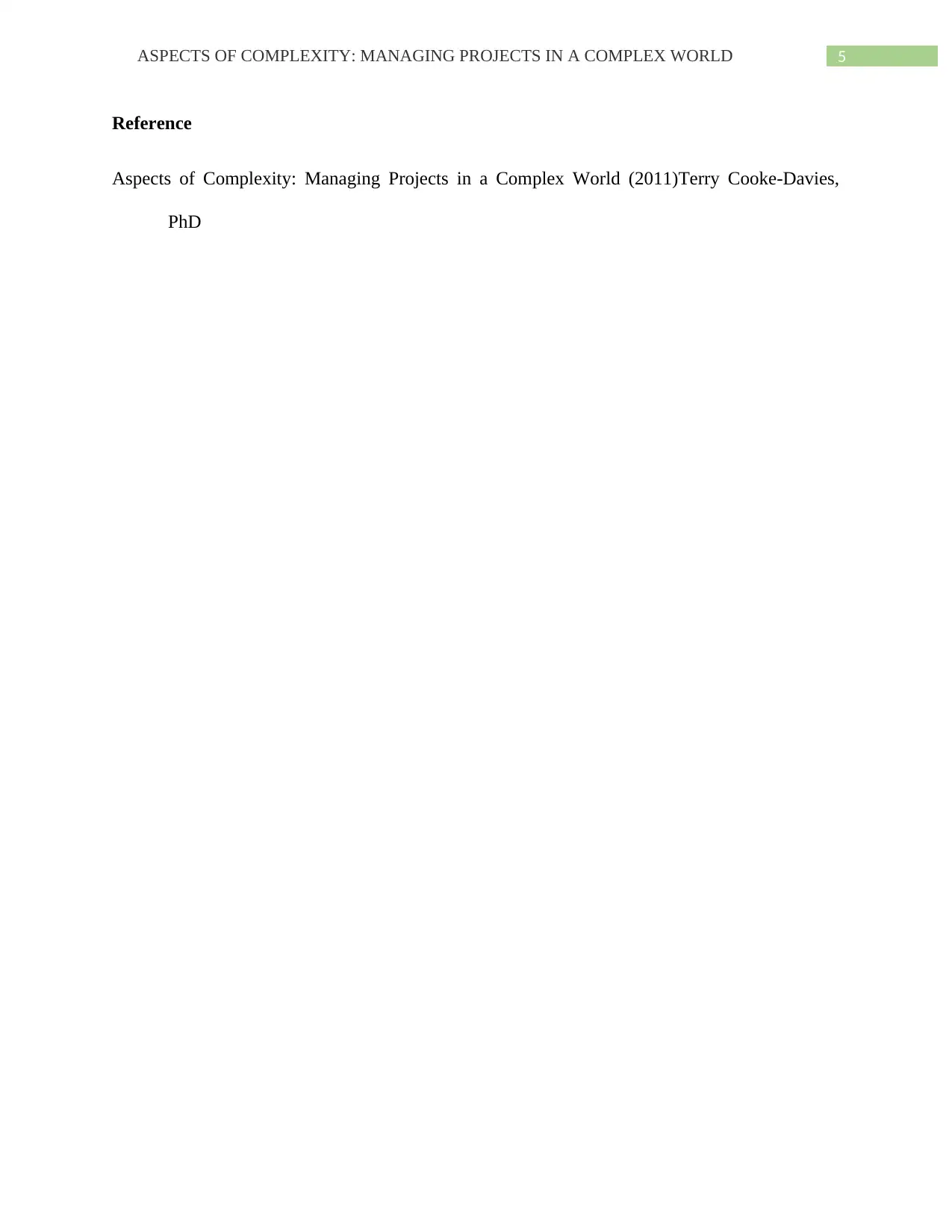
5ASPECTS OF COMPLEXITY: MANAGING PROJECTS IN A COMPLEX WORLD
Reference
Aspects of Complexity: Managing Projects in a Complex World (2011)Terry Cooke-Davies,
PhD
Reference
Aspects of Complexity: Managing Projects in a Complex World (2011)Terry Cooke-Davies,
PhD
⊘ This is a preview!⊘
Do you want full access?
Subscribe today to unlock all pages.

Trusted by 1+ million students worldwide
1 out of 6
Related Documents
Your All-in-One AI-Powered Toolkit for Academic Success.
+13062052269
info@desklib.com
Available 24*7 on WhatsApp / Email
![[object Object]](/_next/static/media/star-bottom.7253800d.svg)
Unlock your academic potential
Copyright © 2020–2025 A2Z Services. All Rights Reserved. Developed and managed by ZUCOL.




